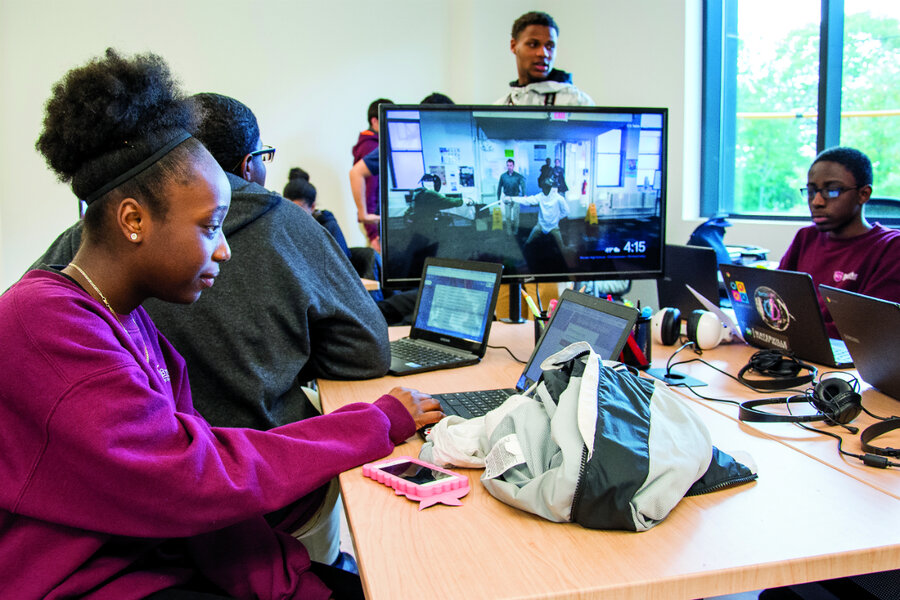More girls, African-Americans enroll in AP computer science. Why that matters.
Loading...
| Boston
‘You are role-playing a turtle. You can only move forward and only turn left. Remember, be the turtle.”
The students listen to their teacher’s instructions and dutifully turn to their laptops, where the challenge awaits. On the screen is a small white box and a small black turtle, and next to it a larger box appears to type in their code. The room fills with clicking sounds and hushed whispers as the students get to work on their challenge: Program the turtle to move along the square path.
Mike Liang, the students’ computer science teacher, walks around the classroom dropping hints. Students cheer quietly as their turtles scuttle across the screen. They are good at this; some have been doing it since the first grade.
Why We Wrote This
Silicon Valley has long been disproportionately male. To get more women and minorities into well-paying jobs, experts say programming is key, and the AP computer science classes are seen as an on-ramp to programming careers.
Brooke High School is a charter school located in the Mattapan neighborhood of Boston with a student body that is more than 80 percent African-American. And its computer science-heavy curriculum reflects the rumblings of change across American education. More high school students than ever are taking the College Board’s Advanced Placement (AP) computer science exams, and those taking them are increasingly female and people of color.
In fact, the College Board reports that from 2017 to 2018 female, African-American, and Hispanic students were among the fastest growing demographics of AP computer science test-takers, with increases in exam participation of 39 percent, 44 percent, and 41 percent, respectively. These increases are higher than the overall 31 percent bump in exam participation – a sign that computer science is becoming more accessible to underrepresented groups. For context, in 2007, fewer than 3,000 high school girls took the AP Computer Science A exam; in 2018, more than 15,000 completed it.
From college campuses to major technology companies, the typical profile of a computer scientist as a white, or Asian, man persists. Apple, Google, and Microsoft report that fewer than 35 percent of their employees are women and that more than 50 percent are white. These programs at the high school level are aiming to create more diversity by giving students the confidence to pursue tech later on.
“If [more female and minority] students take computer science in high school, in college, then hopefully one day these students will join the tech force, and we’ll see a larger representation of America,” says Alice Steinglass, president of Code.org, a nonprofit dedicated to expanding access to computer science in schools.
One driver of that change is AP Computer Science Principles, a course launched by the College Board in 2016 as an alternative to the programming-heavy AP Computer Science A. The new course aims to give students a broader – and gentler – introduction to computer science by helping them understand its relevance to their lives. While still early, there are signs that it is broadening the profile of who signs up for the course. In 2016, 13,506 high school girls enrolled in a computer science-related AP course; in 2018, that number jumped to 38,000.
“Students interested in medicine are creating apps in that field, while students passionate about reading are creating apps that allow them to share that love of reading,” says Maureen Reyes, executive director of the AP program at the College Board. “So it really does allow each student to pursue their passions, which broadens who can participate in computer science.”
The number of students scoring a 3 (a passing score) or higher on the AP CSP exam has increased proportionally with the uptick in participation. Among Hispanic/Latino students, for example, around 54 percent of students passed the exam in both 2017 and 2018, even while the number of these students taking AP CSP grew by 63 percent.
In order to increase participation at underserved schools, the College Board partners with providers, such as Code.org, to train educators on the material. Code.org’s one-week workshop brings teachers together to learn course material and to network and offers additional support throughout the year. Teachers with many underrepresented minorities at their schools are eligible for scholarships to attend the workshop, Ms. Steinglass says, and there are grants in some states to subsidize the cost.
At Brooke High School, for instance, graduation requires taking three years of computer science and passing the AP Computer Science Principles exam.
But at a school where the most popular extracurricular is the Robotics Club, students don’t seem to mind.
“Technology is in the future, and this prepares us for it,” says Geraldine Louis, a junior, as she sits through a bustling Robotics Club meeting. Geraldine says she finds computer science difficult but that she likes building things and especially showing off the team’s robot at competitions.
“After all this time [together], it’s become a community for me,” she says.






